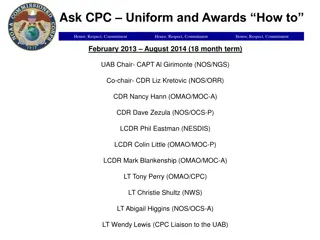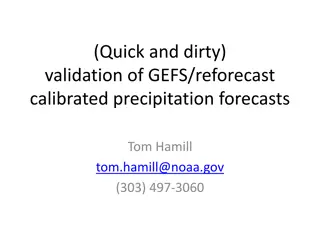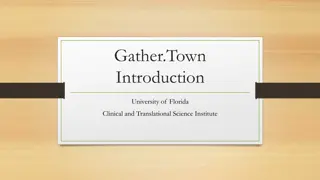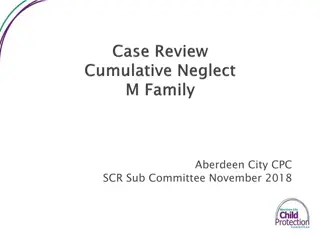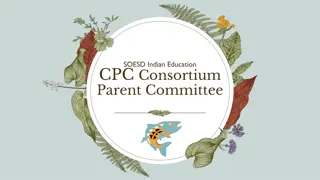
AVATAR Leadership and Student Success Strategy at North Texas Community College Consortium
Explore the innovative AVATAR College Preparatory Course (CPC) Project presented at the Spring Leadership Conference. Discover how vertical alignment and the AVATAR model contribute to student success through data analysis, P-16 Pipeline insights, and student participation in advanced courses. Dive into the statistics of high school graduates' college readiness and completion rates.
Download Presentation

Please find below an Image/Link to download the presentation.
The content on the website is provided AS IS for your information and personal use only. It may not be sold, licensed, or shared on other websites without obtaining consent from the author. If you encounter any issues during the download, it is possible that the publisher has removed the file from their server.
You are allowed to download the files provided on this website for personal or commercial use, subject to the condition that they are used lawfully. All files are the property of their respective owners.
The content on the website is provided AS IS for your information and personal use only. It may not be sold, licensed, or shared on other websites without obtaining consent from the author.
E N D
Presentation Transcript
1 College Preparatory Course Project North Texas Community College Consortium, Spring Leadership Conference January 30, 2015 http://untavatar.org
2 Presentation Overview 1. Vertical alignment and AVATAR model 2. Highlights of HB 5 3. AVATAR College Preparatory Course (CPC) Project 4. AVATAR CPC: a leadership and student success strategy
3 Vertical alignment and AVATAR
4 Foundations of AVATAR Closing the Gaps Student Participation 1. Student Success 2. Source: Closing the Gaps Progress Report, June 2012 Retrieved from: http://www.thecb.state.tx.us/index.cfm?objectid=858D2E7C-F5C8-97E9- 0CDEB3037C1C2CA3
5 The Texas P-16 Pipeline, 2007
6 TAPR Data from TEA Percent College Ready High School Graduates, 2013-2014 Public High All African American Hispanic White Asian Other Descriptors of Student Body in Percentages: School Graduates Class of 2013 N=301,418 ELA 65 Mathematics 74 53 60 58 69 75 83 80 90 Both subjects 56 41 48 69 77 http://untavatar.org
7 TAPR Data from TEA Percent Advanced Course Dual Credit Completion in 2013-14 Other Descriptors of Student Body in Percentages: Public High School Students, 2013-2014 All African American Hispanic White Asian 2013 2012 31.4 30.5 24.2 24.0 28.5 26.2 35.6 34.9 57 55.7 http://untavatar.org
8 TAPR Data from TEA Percent AP/IB Enrollees Tested and Meeting Criteria in 2013-14 Other Descriptors of Student Body in Percentages: Public High School Students All African American Hispanic White Asian Tested Met Criteria 22.1 50.9 13.7 27.3 19.5 37.5 24.9 64.3 53.6 72.5 http://untavatar.org
9 Percent 2012 Graduates Enrolled in IHE and Completing One Year without Remediation Other Descriptors of Student Body in Percentages: Public High School Graduates Class of 2012 All African American Hispanic White Asian Enrolled Completed One Year no Remediation 57.3 69.0 na na na na na na na na http://untavatar.org
10 What is Alignment? Alignment assumes a standards-based system of curriculum and assessment. Vertical alignment attends to articulation of curriculum across levels of education and requires willingness to focus instruction, assessment, staff development, and management so that students succeed. Horizontal alignment attends to student learning in every section of the same grade or class. Reference: Squires, D. A. (2009). Curriculum Alignment: Research-Based Strategies for Increasing Student Achievement. Thousand Oaks, CA, Corwin,
11 Alignment Research Squires (2009) reviews research and concludes: Alignment improves student outcomes. Alignment is a powerful tool for assuring the written, taught and tested curriculum are the focus of instruction, assessment, and faculty development. 1. 2. Reference: Squires, D. A. (2009). Curriculum Alignment: Research-Based Strategies for Increasing Student Achievement. Thousand Oaks, CA, Corwin,
12 AVATAR: Academic Vertical Alignment Training And Renewal
13 S c a f f o l d i n g S c a f f o l d i n g S t u d e n t S t u d e n t S u c c e s s S u c c e s s AVATAR is a Partnership of Regional Leaders from these institutions
14 AVATAR Partners Partnerships: Leaders and educators representing regional Independent school districts (ISDs) Community colleges, Universities, P-16 councils, and education service centers (ESCs) are committed to vertical alignment to support students college and career readiness and success. http://untavatar.org
15 AVATAR Vertical Alignment Teams Vertical Alignment Teams (VATs): Educators and leaders representing AVATAR partners who are committed to addressing discipline specific course needs to create environments where students can make successful transitions between and among regional educational systems. http://untavatar.org
16 The AVATAR Process Creates and builds relationships through ongoing critical conversations Uses regional data to make alignment decisions Develops shared understanding of college and career readiness and success for students Identifies and implements intentional actions Evaluates, sustains, and shares vertical alignment work http://untavatar.org
17 AVATAR enables Critical Conversations Post-Secondary Graduate Career Ready Secondary Graduate College/Career Ready Impact of Developmental Education and Texas Success Initiative Student Success Assessments Dual Credit, Early College High Schools Student Support Services Dual Credit, Early College High Schools Student Support Services Educational Policies & Practices Classroom Instruction, Textbooks Grading, etc. Discipline Specific Course Curriculum Educational Policies & Practices Classroom Instruction, Textbooks Grading, etc. Discipline Reference Course Profiles College & Career Readiness Standards Texas Essential Knowledge and Skills
The Statewide Network 18 English Language Arts Mathematics 2013-2014 ESC 6, Sam Houston State University P-16 Council , Sam Houston State University, Lone Star College System, Huntsville ISD, & Sam Houston State University Regional P-16 Council (Huntsville). ESC 2, Citizens for Educational Excellence, Education to Employment Partners P-16 Council, TAMU-Corpus Christi, TAMU-Kingsville, Del Mar College, Coastal Bend College, Robstown ISD, Odem-Edroy ISD, Corpus Christi ISD, & Calallen ISD. Science ESC 1, Upper Rio Grande Valley P- 16, UT-Pan Am, South Texas College, South Texas ISD, Missions ISD, Weslaco ISD, McAllen ISD, & Pharr San Juan Alamo ISD. ESC 9, Region 9 P-16 Council, Midwestern State University, Vernon College, Burkburnett ISD, Wichita Falls ISD, Iowa Park CISD, and Vernon ISD. ESC 9, Region 9 P-16 Council, Midwestern State University, Vernon College, Burkburnett ISD, Vernon ISD, Iowa Park CISD, Windthorst ISD, & Wichita Falls ISD. ESC 10, North Texas Regional P-16 Council, University of North Texas , Dallas CCCD, Brookhaven College, Carrolton Farmers Branch ISD& Dallas ISD. ESC 11, North Texas Regional P-16 Council, Tarleton State University, Hill College, Burleson ISD, Cleburne ISD, Godley ISD, & Joshua ISD. ESC 12, Heart of TX P-20 Council, McLennan Community College, Texas State Technical College, Waco ISD, La Vega ISD, Midway ISD, Robinson ISD, Rapoport Academy, Reicher Catholic School, & Baylor University. ESC 10, North Texas Regional P- 16 Council, University of North Texas , Dallas CCCD, Brookhaven College, Carrolton Farmers Branch & Dallas ISD. ESC 12, Heart of TX P-20 Council, McLennan Community College, Texas State Technical College, Waco ISD, La Vega ISD, Midway ISD, Robinson ISD, Rapoport Academy, Reicher Catholic School, West Midway & Baylor University. ESC 15. San Angelo P-16+ Partnership, Howard College, Angelo State University, San Angelo ISD & TLC Charter School. ESC 16, Panhandle P-16 Council, West Texas A&M University, Amarillo College, Clarendon College, Frank Phillips College, Amarillo ISD, Borger ISD, & Canyon ISD. College Awareness Region 20, P16 Plus Council of Greater Bexar County, UT-San Antonio, Alamo Colleges, Palo Alto College, & Harlandale ISD. ESC 15, San Angelo P-16+ Partnership, Howard College, Angelo State University, Eden CISD, Wall ISD & San Angelo ISD. ESC 7, Deep East Texas P-16 Council/Stephen F. Austin University, Kilgore College, Kilgore ISD, Panola Charter, & Tyler Junior College. Region 20, P16 Plus Council of Greater Bexar County, UT-San Antonio, Alamo Colleges, Palo Alto College, & Harlandale ISD.
19 House Bill 5: Some Important Provisions for College People to Know
20 Graduation Requirements Reduced number of End of Course tests required for graduation from 15 to five. Changed high school graduation programs from minimum, recommended, and distinguished to Foundation Program with options for: Endorsements; Distinguished Level of Achievement; and/or Performance Acknowledgements. . http://untavatar.org
21 Endorsement Options Endorsements STEM (Science, Technology, Engineering, and Mathematics) Business and Industry Public Services Arts and Humanities Multidisciplinary Studies http://untavatar.org
22 Performance Acknowledgements Any student may earn a performance acknowledgement for outstanding performance In dual credit course In bilingualism and biliteracy On AP/IB exam On PSAT, ACT-Plan, SAT, or ACT For earning a nationally or internationally recognized business or industry certification /license http://untavatar.org
23 Locally Developed CTE Courses/Activities Districts may offer courses or other activities, including apprenticeships, needed for industry-recognized credential or certificates http://untavatar.org
24 College Preparatory Courses Districts must partner with at least one IHE to develop college prep courses in math and ELA for 12th grade students who do not meet college readiness standards or whose performance indicates they are not ready for entry-level college coursework. Effective 2013-2014 (with courses to be provided no later than 2014-2015) High school and IHE faculty must meet regularly as necessary to ensure courses are aligned with college readiness expectations. http://untavatar.org
25 AVATAR College Preparatory Course Project, 2014-15
26 Where? http://untavatar.org
27 S c a f f o l d i n g S c a f f o l d i n g S t u d e n t S t u d e n t S u c c e s s S u c c e s s Who?
28 How: The AVATAR Process Creates and builds relationships through ongoing critical conversations Uses regional data to make alignment decisions Develops shared understanding of college and career readiness and success for students Identifies and implements intentional actions Evaluates, sustains, and shares vertical alignment work http://untavatar.org
29 What is going on in the regions? Results of December 2014 AVATAR Survey http://untavatar.org
30 CPC Survey Results Status of College Preparatory Courses by Region 9 8 7 6 # of Regions 5 4 3 2 1 0 Just getting Started Syllabus and related documents well underway Agreements in place for course to be offered Course being offered fall 2014 Other ELA Math
31 Overview of the Courses Mathematics Offered by 5 partnerships 4 face to face; 1 online All 5 offered for two semesters 4 offered for high school credit; 1 not for credit, no dual credit 4 meet high school graduation requirements; 1 does not English Language Arts Offered by 4 partnerships 3 face to face; 1 online 1 offered for one semester; 3, two semesters 3 offered for high school credit, 1 not for credit, no dual credit All meet high school graduation requirements
32 Overview of Enrolled Students (Regions 1, 2, 16, 19, 20) Mathematics Seniors and some juniors English Language Arts Seniors Not TSI ready in Reading and Writing Not TSI ready in Mathematics Mainly Hispanic Mainly Hispanic At least 750 in 4 regions At least 1100 in 5 regions
33 Sample academic criteria Mathematics College Readiness 80% or higher course grade English Language Arts College Readiness 75% or higher course grade and a score of at least 3 on the STAAR writing rubric for each of the 5 assigned essays 70% of higher course grade 70% or higher in course and on final exam 75% or higher in course and at least 60% on the final exam
34 What are your concluding observations?
35 Our Concluding Observations In Texas, College Preparatory Courses are most implemented on the border. Defining local partnerships is harder and riskier in more populous and diverse regions of the state. By providing for College Preparatory Courses, Texas joined 37 other states that are exploring transitional courses as an alternative to developmental or remedial education. http://untavatar.org
36 Our Concluding Observations Create partnerships with the ISDs that are your largest feeders. Study students college and career needs and how they might be addressed. Consider the various provisions of HB5 that call for collaboration between school districts and colleges CPC, CTE, endorsements, dual credit, ECHS, etc. Academic collaboration requires thoughtful participation of both faculty, staff, and administrators. http://untavatar.org
37 Presenters M. Jean Keller Professor and Acting Vice President Mary M. Harris Regent Professor Emerita Co-director, AVATAR Director, AVATAR University of North Texas University of North Texas Denton, TX Denton, TX Mary_harris@unt.edu Jean_keller@unt.edu 940 367-3026 940 565-3427





